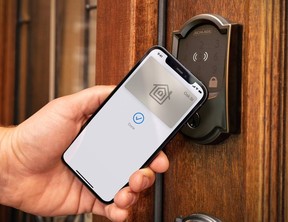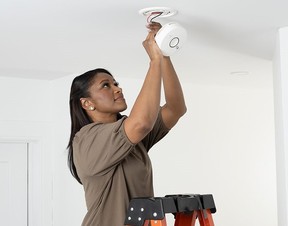SALTZMAN: Home, smart, home | Toronto Sun
We may still be a few years away from a humanoid robot that can wash our dishes and make our beds – like Rosie, the cheeky robotic housekeeper from The Jetsons – but today’s “smart home” devices can do so much, yet cost very little.
Article content
Not only do these gadgets let you easily control your home with an intuitive app or by using your voice through a nearby smart speaker, but you can automate tasks, too, like having the lights turn off in a room when you walk out.
Article content
Smart home tech can also give you peace of mind (security cameras and video doorbells) and save you money (Wi-Fi thermostats, smart lights).
The following are seven ideas for what’s new and newsworthy this Spring.
THROW SOME SHADE
From Toronto-based RYSE, SmartShade ($199; helloryse.com) is the first device to motorize any window shade that has a beaded chain.
Advertisement 3
Article content
Once you affix the doohickey to the side of the window frame and loop the metal or plastic chain, you can have your blinds raised or lowered in four ways: press the button on the device itself; use the RYSE app (even when you’re not at home), tell your smart speaker to do the task (works with Google, Alexa, and Apple’s Siri via HomePod), or set schedules to raise and lower the blinds at certain times of the day (some of these options require the RYSE SmartBridge, for $99).
RYSE SmartShade is also ideal for hard-to-reach windows or for those with mobility or dexterity challenges.

TEMP WORK
For comfort and cost savings, control your home’s temperature from anywhere or let your home automatically adjust to your schedule. It’s easy with the latest crop of smart thermostats, such as the feature-rich Honeywell Home T9 Smart Thermostat ($219; amazon.ca).
Article content
Advertisement 4
Article content
Compatible with forced air (gas, oil, or electric), hot water and steam, and heat pumps with electric backup, this smart thermostat also supports optional wireless smart room sensors for optimum temps and humidity in specific spaces (because of its occupancy detection).
If desired, see your energy use in a monthly energy report via email, to find additional ways to save.

WHO CAN IT BE NOW?
Video doorbells let you see who’s at your front door – whether you’re home or not – and talk with visitors through its integrated microphone and speaker.
That is, you can chat with whomever is on your doorstep through the companion app or if you own a compatible smart speaker or smart display while inside.
Some of the big brands, though, charge you a subscription fee to see video of your front door at a previous time (even if it was 5 minutes ago), but Toronto-based Lorex has a 2K Wired Video Doorbell ($229; lorex.ca) that doesn’t require you to pay for “cloud” storage because recordings are stored locally.
Advertisement 5
Article content
Same goes for its weatherproof Wi-Fi Floodlight Camera ($249), which houses two ultrabright LED lights (to produce a total of 4,000 lumens) and has a sensor that can turn on when you pull into the driveway.
TO SERVE AND PROTECT
“Latchkey kids” are a thing of the past – so long as they have their smartphone with them (or if they can remember a numeric code).
That is, kids and other family members can walk into the home without a key with the Schlage Encode Plus Smart Wi-Fi Deadbolt ($399; schlage.ca).
The Schlage companion app also lets you send someone – say, to a friend, family member, dogwalker, babysitter, or housekeeper – a temporary, custom code to grant temporary access to your home, and shows you on the app when your lock has been accessed, and by whom.
Advertisement 6
Article content
Along with the app, you can lock your front door, hands-free, by using your voice via a smart speaker while inside.
There are different colours and finishes to choose from.

WHERE THERE’S SMOKE
Smoke and fire alarms aren’t new, of course, but many of the models today are “smart,” and thus can push notifications to your phone through a companion app.
As the name suggests, Kidde’s Smoke and Carbon Monoxide Alarm with Indoor Air Quality Monitor ($149; kidde.com) is the very first all-in-one smart home safety device that integrates smoke and CO detection with indoor air quality monitoring that can detect multiple airborne threats from a single device.
Once it’s on your wireless network and you’re signed into the Kidde app, you’ll receive notifications if smoke, carbon monoxide or indoor air quality issues are detected in your home, plus you can test your alarm from the app, and more.
Advertisement 7
Article content
And while it’s a hardwired solution, it includes a sealed-in lithium backup battery that lasts up to 10 years.

BE A BARBECUE BOSS
Speaking of smoke, if you don’t want to spring for a “smart grill,” such as an app-controlled Traeger wood-pellet smoker, the MEATER 2 Plus ($175; meater.com) lets you barbeque with confidence, as this wireless probe, with multiple sensors, communicates your food’s internal temperature (and grill’s ambient temp), up to 250 feet away (via Bluetooth), to its companion app on a smartphone or tablet.
Ideal for cooking indoors or outdoors (and for camping/glamping trips), this small doohickey works with all cuts of meat (beef, lamb, chicken, and pork), as well as fish.
The app will display alerts, such as when it’s time to flip your steak based on your desired doneness, as well as other handy features.
Advertisement 8
Article content

MASTER CONTROL
To manage and control all these devices, Amazon’s brand-new Echo Hub ($239; amazon.ca) is an 8-inch Alexa-enabled smart home control panel that can mounted to a wall or placed on a table with an optional stand. Supporting thousands of smart home products, you can use your voice or fingertips to see and interact with your tech (like brightening the lights in the room) or you can organize routines, such as saying “Good night” to turn lights off, drop the thermostat down a few degrees, lower the blinds and set the alarm.
Echo Hub uses infrared technology to detect when you approach, which is convenient.
Because it’s Alexa-enabled, you can also use your voice to ask for information (“How long will it take for me to drive to work today?” or “Show me a recipe for chocolate chip cookies”), play music, podcasts, YouTube videos, and more.
Article content




